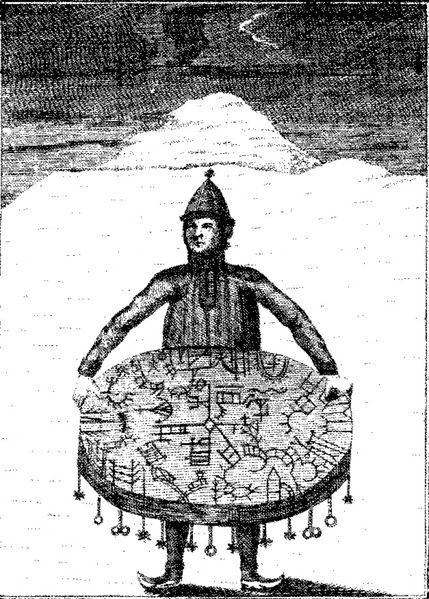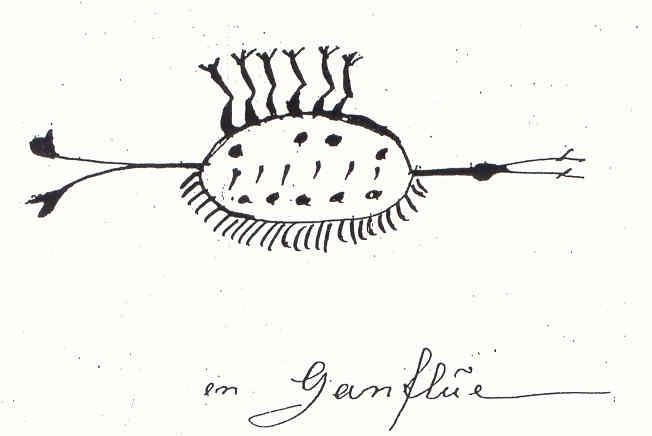Medieval Shamanic Account from Iceland January 17, 2014
Author: Beach Combing | in : Medieval , trackback‘Shaman’ is a much misused word. But here is a medieval account of shamnism from northern Europe that is, to the best of this blogger’s knowledge without parallel. The text is a saga: Vatnsdaela Saga, a thirteenth-century Icelandic text. The author tells of Ingimundr the Old who was born and brought up in northern Norway. One day the young Ingimundr went to a feast there and met a prophesysing Sami woman who told him that he would emigrate to Iceland and the find there a tiny statuette of the goddess Frey that he had lost. Now that would be shamanic enough for most of us, but what is incredible is Ingimundr’s next move.
[Ingimundr] went home and remained on his farm. He sent for the Lapps, and three of them came from the north. Ingimund said that he wanted to make a bargain with them – ‘I will give you butter and tin, and you are to undertake an errand for me in Iceland and search for my amulet and report back to me about the lie of the land.’
Síðan skildu þeir konungur. Fór Ingimundur heim og sat að búm. Hann sendir eftir Finnum og komu norðan þrír. Ingimundur segir að hann vill kaupa að þeim ‘og vil eg gefa yður smjör og tin en þér farið sendiferð mína til Íslands að leita eftir hlut mínum og segja mér frá landslegi.’
So far it sounds as if the messengers are going to catch a boat. Not a bit of it…
They answered ‘This is a hazardous mission for Lapp messengers to undertake, but in response to your request we want to make an attempt. You must now shut us up together in a shed and our names must not be revealed.’ This was duly done. And when three nights had passed, Ingimund went to them.
They stood up and signed deeply and said, ‘It has been hard for us, and we have had much toil and trouble, but nevertheless we have returned with these tokens so that you may recognise the land from our account, if you go there; but iw as very difficult for us to search for the amulet, and the spell of the Lapp woman was a powerful one because we placed ourselves in great jeopardy. We arrived at a spot where three fjords open up to the north-east and in one fjord there were big lakes to be seen. We later entered a long valley and there at the foot of a mountain were some wooded areas. It was a habitable hillside, adn there in one of the woods was the amulet, but when we tried to pick it up, it flew off into another wood, and as we pursued it, it always flew away, and some sort of cover always lay over it, so that we could not get hold of it; and so it is that you yourself must go there.’
Þeir svara: ‘Semsveinum er það forsending að fara en fyrir þína áskorun viljum vér prófa. Nú skal oss byrgja eina saman í húsi og nefni oss engi maður.’
Og svo var gert. Og er liðnar voru þrjár nætur kom Ingimundur til þeirra.
Þeir risu þá upp og vörpuðu fast öndinni og mæltu: ‘Semsveinum er erfitt og mikið starf höfum vér haft en þó munum vér með þeim jarteinum fara að þú munt kenna land, ef þú kemur, af vorri frásögn en torvelt varð oss eftir að leita hlutinum og mega mikið atkvæði Finnunnar því að vér höfum lagt oss í mikla ánauð. Þar komum vér á land sem þrír firðir gengu af landnorðri og vötn voru mikil fyrir innan einn fjörðinn. Síðan komum vér í dal einn djúpan og í dalnum undir fjalli einu voru holt nokkur. Þar var byggilegur hvammur og þar í holtinu öðru var hluturinn. Og er vér ætluðum að taka hann þá skaust hann í annað holtið og svo sem vér sóttum eftir hljóp hann æ undan og nokkur hulda lá ávallt yfir svo að vér náðum eigi og muntu sjálfur fara verða.’
This is very much the Lapp/Sami shamanic tradition as understood today and still practised in some remote corners of the globe: a ‘spiritual’ flight in search of answers and, rather incredibly, an attempt here to pick up a physical object. Ingimundr, of course, goes to Iceland. Other early shamanic accounts? drbeachcombing AT yahoo DOT com
20 Jan 2013: MC sends in this fascinating pdf piece and Wade a second. Both well worth a read! Thanks to MC and Wade!
31 Jan 2015: An old friend of this blog and expert on the cold north, Leif, writes: Thanks for your account of Sami shamanism from the Vatnsdaela Saga. Really wonderful. The section you quote is based on Sami tradition. This tradition existed as late as the mid 1800s, according to Læstadius’ account (written 1838–1840). ‘Noaide’ is the Sami word for shaman. The Norwegian word is ‘Gandfinn’, which is poetic, but out of fashion today because of it’s negative connotations.’ And here is a fragment of relevant text. Læstadius, Lars Levi (Pentikäinen, Julia- translator)Fragments of Lappish Mythology Beaverton, Ontario: Aspasia Books, 2002 Part 3: Doctrine of Divination, chapter 20, pp 218-219 Both Olaus Magnus (1490-1557) and Olaus Petri (1493-1555) state that Lappish noaide fetch some token from the place they have visited while in a trance. This is most likely tale-spinning, to be valued as one sees fit. Olaus Petri’s words read thus: “To give more weight to their statements, they brought with them a knife, a shoe, a ring or some other object known to the questioner as testimony that the commission had been successfully fulfilled.” This is probably the height of hocus-pocus. I have actually heard a tale of what happened in Muonionniska 60 or 70 years ago, when the sheriff of this region made a journey to Russian Lapland and met some Lapps from the Kola area there; Tornaeus and von Westen say the most ill-tempered of all Lapps lived there. The sheriff of Muonionniska met a Lappish woman there, who must really have demonstrated an ability to conjure. The sheriff, to wit, had mocked their sorcery and said that they merely faked it in order to frighten people. Then the woman said that the sheriff would indeed get a demonstration of her ability and would vouch for it when he got home. At that moment, she went out, and then came back in within a short time. – When the sheriff arrives home, he finds his wife ailing. She asks him what in the world he has done to the Lappish woman since she, on a certain day and at a certain hour, has come to her with a goblet of blood from which she has tried to force the sheriff’s wife to drink. Then the sheriff remembers that on just that day when the clock struck just that hour, he has teased the Lappish woman in Russian Lapland. If this story is true, as my informant has assured me, it is a truly remarkable manifestation of repnesentatio magica. That the woman herself in the flesh should have traveled back and forth a distance of some 50-60 leagues in such a short time is against all the laws of nature. She may have affected the senses or the sensing organs of the sheriff’s wife and thus created an image in her mind so sharp that it seemed real. With regard to dreams and other psychological phenomena, it is clear that the soul’s inner perception is as clear as and sometimes clearer than that based on external reality; such inner perception the perceiver hilllself cannot distinguish from actual outer perception during the time of perception. Insofar as the Lappish woman had this wonderful power which enabled her to project her knowledge outside of time and place, it was by no means impossible for her to get in contact with the sheriff’s wife in a few minutes and bring to life said image. Let this example shed light on the Lappish noaide’s ability to fetch some token from a faraway place. No article of faith is in question. Let the reader decide the matter however he wishes, on condition that anyone who denies genuine historical fact out of sheer stupidity or lack of psychological knowledge, be esteemed less than a four-legged beast.’ Thanks Leif, outstanding stuff!
14 Feb 2014, Leif again: ‘From Trond Gabrielsen’s page on the internet (three excerpts below). As Gabrielsen writes in Norwegian, have provided translations. ‘Gand’ (pronounced gann) is a Norwegian word which can refer to Sami sorcery or to a projectile used by a Sami sorcerer in his magic. The word refers exclusively to Sami magic and to black magic more often than white. The Sami use a word ‘noaide, which refers to a Sami shaman. Many years ago, I read about a Gannfinn who fell into a trance in his hut. A Gandflue (Gandfly) crawled out of the Gandfinn’s (Sami sorcerer’s) nostril and it’s bite was invariably fatal. Haven’t found much about this kind of magic in English translation. Jón Árnason in Íslenzkar Þjóðsögur og Æfintýri (Icelandic Folktales and Legends) recounts a tale ‘The wizards of Westemanneyar’, which contains a gandkulle, but the tale takes place in Iceland, and Sami are not mentioned. Jonas Lie, in ‘Trold’ (1891-2) contains a story in which a Gandfinn figures prominently- Jack of Sjøholm and the Gandfinn. An English translation ‘Weird tales from northern seas’ is available from gutenberg.org. I recommend it to anyone interested in scary fairies. PS JRR Tolkien appropriated Gandalf’s name from the “Catalogue of Dwarves” in the Völuspá. The Old Norse name Gandalfr incorporates the words gandr meaning “wand”, “staff”, or (especially in compounds) “magic” and álfr “elf”. [Solopova, Elizabeth (2009), Languages, Myths and History: An Introduction to the Linguistic and Literary Background of J.R.R. Tolkien’s Fiction, New York City: North Landing Books, p. 20, ISBN 0-9816607-1-1]’ The picture is a Gandflue!




